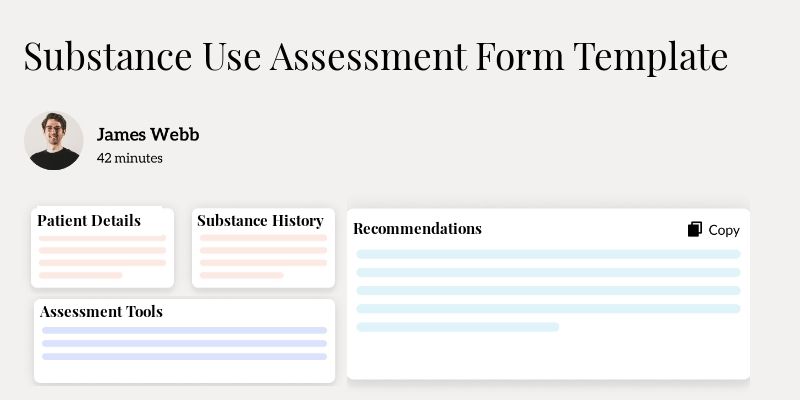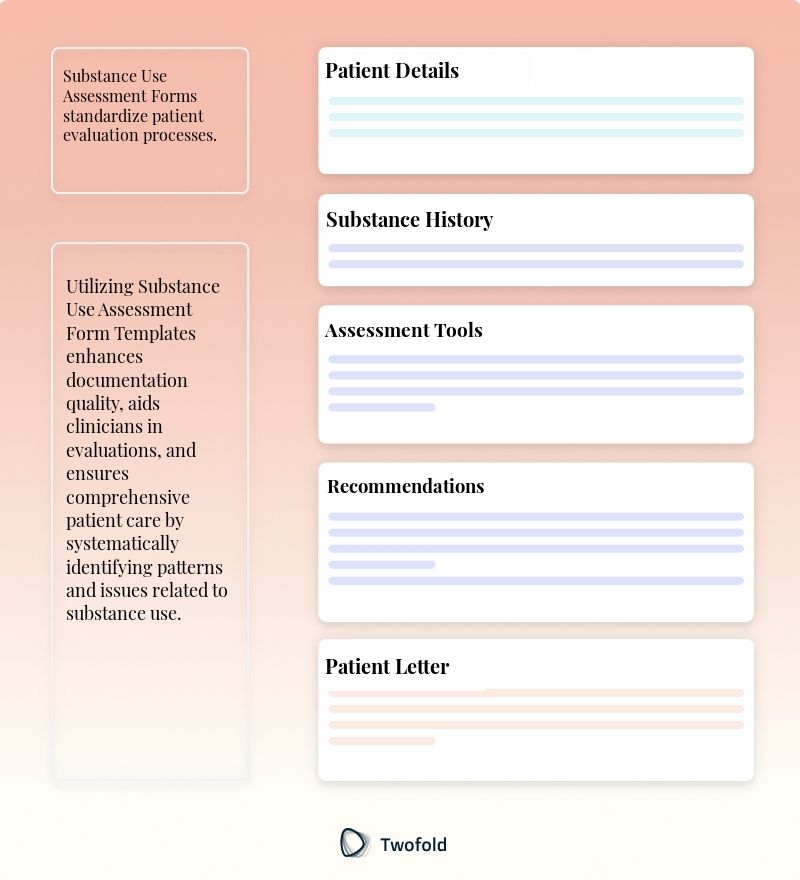
Substance Use Assessment Form Template
Discovering the right tools for dealing with substance use assessments can be challenging. Many healthcare professionals struggle with ensuring accuracy, maintaining consistency, and capturing all the necessary details. This is exactly why we've taken a closer look at the Substance Use Assessment Form Template, aiming to alleviate some of the pressure and offer a comprehensive guide on how to make it work seamlessly in your practice.
What Is a Substance Use Assessment Form Template?
The Substance Use Assessment Form Template is a structured document designed to facilitate the evaluation of a patient's substance use behaviors and related health concerns. It allows healthcare professionals to systematically gather information pertinent to a patient's use of alcohol, drugs, or other substances.
This template aims to standardize the documentation process, reducing variability and ensuring all critical aspects of substance use are comprehensively recorded. This form forms the basis for developing a tailored treatment plan that addresses the unique needs of each patient.
Key Components of a Substance Use Assessment Form
The assessment form is designed to capture essential data effectively. Its fundamental components include:
- Patient Information: Basic personal details and identifiers.
- Substance Usage History: Types of substances used, frequency, and duration.
- Behavioral Impacts: Effects of substance use on daily life and behavior.
- Health Implications: Physical and mental health symptoms related to substance use.
- Screening Results: Scores from standardized screening tools.
- Treatment History: Previous treatments or interventions, if any.

How to Use a Substance Use Assessment Form Template: Step-by-Step Process
Step 1: Acquire the Template
Download the latest version of the form to ensure all sections align with current practices.
Step 2: Begin with Basic Information
Fill out the patient's demographic information to create the foundational context for the assessment.
Step 3: Substance Tracking
Accurately document the patient’s substance use, including type, amount, and pattern of use.
Step 4: Assess Behavioral and Health Impacts
Detail the psychological and physical effects of substance use on the patient’s life.
Step 5: Evaluate Screening Scores
Input results from any substance use screenings to inform the assessment's findings.
Step 6: Review and Plan
Review the collected data to develop a next‑step care plan, using templates as a guideline.
Benefits of a Substance Use Assessment Form
Benefit | Explanation |
|---|---|
Consistency | Ensures uniform data collection across cases, aiding in reliable analysis and comparison. |
Compliance | Helps meet documentation standards required by health care authorities and insurance companies. |
Efficiency | Streamlines the documentation process, thereby saving valuable time for healthcare providers. |
Improved Communication | Facilitates better communication among multi-disciplinary teams involved in patient care. |
Stakeholders in Substance Use Assessment
The form's impact spans a variety of stakeholders, each playing a role in its application and effectiveness.
- Healthcare Providers: A family doctor using the form to refer a patient to specialized treatment programs.
- Patients: A patient leveraging the assessment to better understand their own health profile and need for intervention.
- Insurance Companies: Insurers rely on these assessments to verify the necessity of coverage for treatments.
- Regulatory Bodies: Health departments examining these forms during audits to ensure adherence to public health standards.
Example of a Substance Use Assessment Form PDF
A digital representation of the form can exemplify its layout and typical data fields, providing a visual guide to its application.
Real-World Use Cases: Practical Impact of the Substance Use Assessment Form Template
In practice, this template offers significant benefits across diverse situations, demonstrated by real‑world applications:
- In an urban clinic, a social worker leverages the form to connect patients with community resources swiftly and effectively.
- At a rural hospital, doctors use it as a preliminary step in telehealth consultations to tailor remote care interventions.
- In an educational seminar, the form helps illustrate the link between substance use patterns and health outcomes to student audiences.
Conclusion
The Substance Use Assessment Form Template is invaluable in improving patient evaluations, fostering comprehensive care, and enhancing communication between healthcare stakeholders. Its standardization facilitates efficient data gathering while ensuring crucial patient details and health aspects are explored thoroughly. Embracing this template can lead to better‑informed clinical decisions, with the added benefit of a structured approach aligning with industry standards.
Disclaimer: This article is for informational purposes only and does not constitute legal or medical advice. Always consult professional guidelines and regulatory bodies for specific compliance requirements.

Dr. Danni Steimberg
Dr. Danni Steimberg is a pediatrician at Schneider Children’s Medical Center with extensive experience in patient care, medical education, and healthcare innovation. He earned his MD from Semmelweis University and has worked at Kaplan Medical Center and Sheba Medical Center.
A thorough assessment must move past tallying drinks or pills ‑ it should map patterns, risks, and motivation for change. The CRAVE checklist ‑ Current use, Risk factors, Attempts at abstinence, Verification, Engagement plan ‑ turns each section into actionable data for treatment planning and reimbursement.
- Current use and context: Record frequency, route, quantity, and key triggers for every substance so interventions match real-life patterns.
- Risk factors and relapse history: Log co-occurring disorders, social stressors, and prior overdoses to justify higher levels of care when warranted.
- Verification and engagement: Note toxicology results and the client’s stage of change, then outline the first follow-up step - this closes the loop for payers and keeps the client on track.
Frequently Asked Questions
Reduce burnout,
improve patient care.
Join thousands of clinicians already using AI to become more efficient.

Patient Feedback Note Template
Discover practical Patient Feedback Note templates to enhance your documentation efficiency.

Client Feedback Form Template
Discover practical Client Feedback Form templates to enhance your documentation efficiency.

Care Coordination Plan Template
Discover practical Care Coordination Plan templates to enhance your documentation efficiency.

